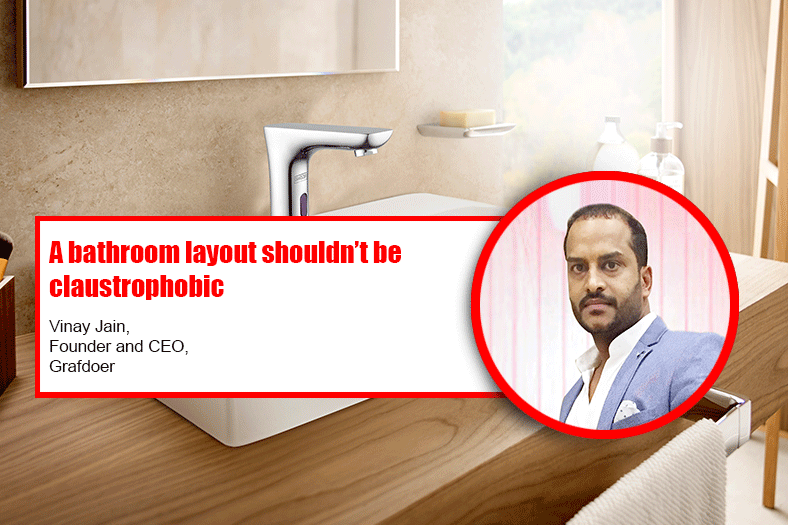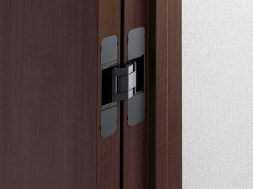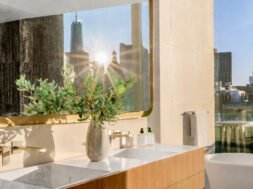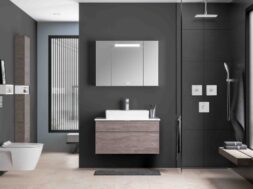A bathroom layout shouldn’t be claustrophobic

An all-white motif is best for creating an open feel, but soft neutrals and pastels in lighter shades are also effective and this is one of the most common space enlarging colour schemes says Vinay Jain, Founder and CEO, Grafdoer.
When it comes to designing a bathroom, what are some of the finer aspects to be kept in mind to ensure it doesn’t look claustrophobic?
Bathrooms are usually smaller than the other spaces in a home. They are perfectly functional but restrictive architecture can limit their potential. Therefore, irrespective of the area of a bathroom, there are ways to have a bathroom layout in such a way that it doesn’t seem claustrophobic. An all-white motif is best for creating an open feel, but soft neutrals and pastels in lighter shades are also effective. In fact this is one of the most common space enlarging colour schemes. One can also maximize the number of mirrors apart from which there should be a major focus on adequate lighting. Eliminating shadows and illuminating a small space with sufficient lighting can make the space look bigger. One of the most recurring issues with people is that they don’t want to compromise with the size of the tub or shower placed and therefore, installing a clear glass shower door is the best way to enhance the space and make it look less claustrophobic.
Especially in public bath spaces, what kind of design changes will become mandatory after the pandemic induced distancing?
Washrooms are one of the most essential spaces in public. Therefore, the bathroom should be provided with amenity options of hand hygiene. This can help in removing pathogens from hands and thereby also help in reducing the spread of Covid-19.The air in an enclosed space like a public restroom can have coronavirus particles in it for several hours, even after the facility has been used by an infected individual. Hence it is more than necessary to ensure that the bathroom is provided with good ventilation. Since Covid-19 promotes a no-touch policy in public places and entails social distancing or object distancing, this can be achieved by automated technologies like motion sensors and wave-to-open switches, as well as hand-free hardware like foot pedals and hip pulls. Hands-free solutions offer quick and easy retrofit opportunities. Opting for turn-around corner entryways in place of standard entry doors. Introduction of touch-free faucets, soap dispensers or sink, pedal hand faucets can also be helpful.
In bath spaces of residential and commercial buildings, what kind of sanitary ware should be utilised to ensure efficient use of water?
With around 30 per cent of a home’s water consumption being flushed down the toilet, swapping out an old inefficient toilet with a water-efficient, the low-flush model can reduce water consumption by 30 to 60 per cent! A low-flush (AKA low-flow) toilet uses a lot less water per flush, saving in the long run. Showerhead replacements are a must when renovating a bathroom. Over time shower heads can get clogged with mineral deposits, which can reduce water pressure. Dual flush toilets are a revolutionary invention as they save up to 30 per cent of water. Bathroom renovations that include a toilet, should add dual flush toilets to the list. The leaky faucets should also be taken into the consideration, as this way water can be efficiently utilized in residential and commercial buildings.
Keeping in mind the current scenario, what additional measures may be necessary to keep bath spaces sanitized?
Keeping toilets, sinks, counters and showers as germ-free as possible is the key to keeping oneself healthy. It is important to clean the door handles, taps, bidet shower, countertops, basins, mirrors, walls behind the basins and the paper and soap dispensers in the toilet with a wet cloth and multi-purpose disinfectant. Special attention should be given to cleaning contact surfaces. It’s important to focus on cleaning “high-touch” areas of the bathroom including light switches, doorknobs and the sink areas in particular. That can also include less obvious areas everyone in the house likely touches, including showerheads, shower curtains and around the toilet seat. We just need to make sure that every place in the surrounding is sufficiently sanitized and properly treated with disinfectants.
Cookie Consent
We use cookies to personalize your experience. By continuing to visit this website you agree to our Terms & Conditions, Privacy Policy and Cookie Policy.









